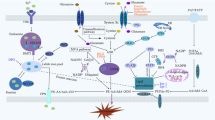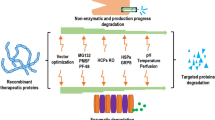Abstract
HFE7A is a mouse anti-human/mouse Fas monoclonal antibody which, protects mice from fulminant hepatitis induced by Jo2. Herein, we report on the mechanism of the protective effect of HFE7A against Jo2-induced acute and lethal hepatic injury. HFE7A reduced the serum aminotransferase level which was elevated after Jo2 injection. HFE7A also inhibited caspase activation and mitochondrial depolarization in hepatocytes derived from apoptosis induced by Jo2 injection. The protective effect of HFE7A against Jo2-induced apoptosis in mouse hepatocytes was reproducible in vitro. The cell death and caspase activation in isolated mouse hepatocytes were induced by incubating these cells with Jo2 in vitro, and HFE7A inhibited the cell death and caspase activation in mouse hepatocytes in a dose-dependent manner. The affinity of HFE7A to mouse Fas was lower than that of Jo2. The binding of Jo2 to neither recombinant mouse Fas nor mouse hepatocytes was inhibited by an excessive amount of HFE7A. Interestingly, HFE7A bound to hepatocytes isolated from Fas knockout mice. From these results, it is suggested that HFE7A may exert a protective effect against Jo2-induced hepatitis not by competitively inhibiting the binding of Jo2 to Fas on hepatocytes, and that a distinct molecule other than Fas may possibly be involved in the protective effect of HFE7A against Jo2-induced hepatic injury.






Similar content being viewed by others
Abbreviations
- TNF:
-
Tumor necrosis factor
- NGF:
-
Nerve growth factor
- FasL:
-
Fas ligand
- mAb:
-
Monoclonal antibody
- HTLV-I:
-
Human T cell leukemia virus type I
- RA:
-
Rheumatoid arthritis
- SCID:
-
Severe combined immunodeficient
- i.v.:
-
Intravenously
- i.p.:
-
Intraperitoneally
- AST:
-
Aspartate aminotransferase
- ALT:
-
Alanine aminotransferase
- LDH:
-
Lactose dehydrogenase
- NO:
-
Nitric oxide
- DISC:
-
Death inducing signaling complex
- MORT:
-
Mediator of receptor-induced toxicity
- FADD:
-
Fas-associated protein with death domain
- DR:
-
Death receptor
- COX:
-
Cyclooxygenase
- FcγRII:
-
Fcγ receptor II
References
Adachi M, Suematsu S, Kondo T, Ogasawara J, Tanaka T, Yoshida N, Nagata S (1995) Targeted mutation in the Fas gene causes hyperplasia in peripheral lymphoid organs and liver. Nat Genet 11:294–300
Canbay A, Friedman S, Gores GJ (2004) Apoptosis: the nexus of liver injury and ficrosis. Hepatol 39:273–278
Cazanave S, Vadrot N, Tinel M, Berson A, Letteron P, Larosche I, Descatoire V, Feldmann G, Robin MA, Pessayre D (2008) Ibuprofen administration attenuates serum TNF-α levels, hepatic glutathione depletion, hepatic apoptosis and mouse mortality after Fas stimulation. Toxicol Appl Pharmacol 231:336–343
Costelli P, Aoki P, Zingaro B, Carbo N, Reffo P, Lopez-Soriano FJ, Bonelli G, Argiles JM, Baccino FM (2003) Mice lacking TNF-α receptors 1 and 2 are resistant to death and fulminant liver injury induced by agonistic anti-Fas antibody. Cell Death Differ 10:997–1004
Ellis RE, Yuan J, Horvitz HR (1992) Mechanisms and functions of cell death. Annu Rev Cell Biol 7:663–698
Fiorucci S, Mencarelli A, Palazzetti B, Soldato PD, Morelli A, Ignarro LJ (2001) An NO derivative of ursodeoxycholic acid protects against Fas-mediated liver injury by inhibiting caspase activity. Proc Natl Acad Sci 98:2652–2657
Firestein GS, Yeo M, Zvaifler NJ (1995) Apoptosis in rheumatoid arthritis synovium. J Clin Invest 96:1631–1638
Fujisawa K, Asahara H, Okamoto K, Aono H, Hasunuma T, Kobata T, Iwakura Y, Yonehara S, Sumida T, Nishioka K (1996) Therapeutic effect of the anti-Fas antibody on arthritis in HTLV-1 tax. J Clin Invest 98:271–278
Ichikawa K, Yoshida-Kato H, Ohtsuki M, Ohsumi J, Yamaguchi J, Takahashi S, Tani Y, Watanabe M, Shiraishi A, Nishioka K, Yonehara S, Serizawa N (2000) A novel murine anti-human Fas mAb which mitigates lymphadenopathy without hepatotoxicity. Int Immunol 12:555–562
Itoh N, Yonehara S, Ishii A, Yonehara M, Mizushima S, Sameshima M, Hase A, Seto Y, Nagata S (1991) The polypeptide encoded by the cDNA for human cell surface antigen Fas can mediate apoptosis. Cell 66:233–243
Jodo S, Kung JT, Xiao S, Chan DV, Kobayashi S, Tateno M, Lafyatis R, Ju ST (2003) Anti-CD95-induced lethality requires radioresistant FcγRII+ cells. J Biol Chem 278:7553–7557
Liu X, Kim CN, Yang J, Jemmerson R, Wang X (1996) Induction of apoptotic program in cell-free extracts: requirement for dATP and cytochrome c. Cell 86:147–157
Luo X, Budihardjo I, Zou H, Slaughter C, Wang X (1998) Bid, a Bcl2 interacting protein, mediates cytochrome c release from mitochondria in response to activation of cell surface death receptors. Cell 94:481–490
Matsuki Y, Li L, Hsu HC, Yang PA, Zheng R, Edwards CK III, Chaudry IH, Zhang HG, Mountz JD (2002) Soluble Fas gene therapy protects against Fas-mediated apoptosis of hepatocytes but not the lethal effects of Fas-induced TNF-α production by Kupffer cells. Cell Death Differ 9:626–635
Mizuhara H, O’Neil E, Seki N, Ogawa T, Kusunoki C, Otsuka K, Satoh S, Niwa M, Senoh H, Fujiwara H (1994) T cell activation-associated hepatic injury: mediation by tumor necrosis factors and protection by interleukin 6. J Exp Med 179:1529–1537
Nakajima T, Aono H, Hasunuma T, Yamamoto K, Shirai T, Hirohata K, Nishioka K (1995) Apoptosis and functional Fas antigen in rheumatoid arthritis synoviocytes. Arthritis Rheum 38:485–491
Nishimura-Morita Y, Nose M, Inoue T, Yonehara S (1997) Amelioration of systemic autoimmune disease by the stimulation of apoptosis-promoting receptor Fas with anti-Fas mAb. Int Immunol 9:1793–1799
Ogasawara J, Watanabe-Fukunaga R, Adachi M, Matsuzawa A, Kasugai T, Kitamura Y, Itoh N, Suda T, Nagata S (1993) Lethal effect of the anti-Fas antibody in mice. Nature 364:806–809
Park KT, Mitchell KA, Huang G, Elferink CJ (2005) The aryl hydrocarbon receptor predisposes hepatocytes to Fas-mediated apoptosis. Mol Pharmacol 67:612–622
Pinkoski MJ, Brunner T, Green DR, Lin T (2000) Fas and Fas ligand in gut and liver. Am J Physiol Gastrointest Liver Physiol 278:G354–G366
Raff MC (1992) Social controls on cell survival and cell death. Nature 356:397–400
Rodriguez J, Matsuura K, Ody C, Nagata S, Vassalli P (1996) Systemic injection of a tripeptide inhibits the intracellular activation of CPP32-like proteases in vivo and fully protects mice against Fas-mediated fulminant liver destruction and death. J Exp Med 184:2067–2072
Sakai K, Matsuno H, Morita I, Nezuka T, Tsuji H, Shirai T, Yonehara S, Hasunuma T, Nishioka K (1998) Potential withdrawal of rheumatoid synovium by the induction of apoptosis using a novel in vivo model of rheumatoid arthritis. Arthritis Rheum 41:1251–1257
Schuchmann M, Varfolomeev EE, Hermann F, Rueckert F, Strand D, Koehler H, Strand S, Lohse AW, Wallach D, Galle PR (2003) Dominant negative MORT1/FADD rescues mice from CD95 and TNF-induced liver failure. Hepatol 37:129–135
Suda T, Takahashi T, Golstein P, Nagata S (1993) Molecular cloning and expression of the Fas ligand, a novel member of the tumor necrosis factor family. Cell 75:1169–1178
Trauth BC, Klas C, Peters AM, Matzku S, Moller P, Falk W, Debatin KM, Krammer PH (1989) Monoclonal antibody—mediated tumor regression by induction of apoptosis. Science 245:301–305
Watanabe-Fukunaga R, Brandon CI, Yonehara S, Cropland NG, Jerkins NA, Nagata S (1992) The cDNA structure, expression, and chromosomal assignment of the mouse Fas antigen. J Immunol 148:1274–1279
Wyllie AH, Kerr JFR, Currie AR (1980) Cell death: the significance of apoptosis. Int Rev Cytol 68:251–306
Yonehara S, Ishii A, Yonehara M (1989) A cell killing monoclonal antibody (anti-Fas) to a cell surface antigen co-downregulated with the receptor of tumor necrosis factor. J Exp Med 169:1747–1756
Yoshida-Kato H, Ichikawa K, Yamaguchi J, Watanabe K, Ohsumi J, Yonehara S, Serizawa N (2000) Cloning and expression of a novel murine anti-human Fas antibody. Biosci Biotechnol Biochem 64:1903–1908
Zender L, Hutker S, Liedtke C, Tillmann HL, Zender S, Mundt B, Waltemathe M, Gosling T, Flemming P, Malek NP, Trautwein C, Manns MP, Kuhnel F, Kubicka S (2003) Caspase 8 small interfering RNA prevents acute liver failure in mice. Proc Natl Acad Sci 100:7797–7802
Acknowledgments
We would like to thank Dr. Shin Yonehara (Graduate School of Biostudies, Kyoto University) for kindly providing the Fas knockout mice and for the helpful discussions and also Dr. Jun Ohsumi (Biological Research Laboratories II, Daiichi Sankyo Co., Ltd.) for the helpful discussions. We are also grateful to Dr. Manabu Abe, Ms. Yumiko Fujisawa (Biological Research Laboratories II, Daiichi Sankyo Co., Ltd.), and Ms. Akiko Oguni (Biological Research Laboratories IV, Daiichi Sankyo Co., Ltd.) for their technical support.
Author information
Authors and Affiliations
Corresponding author
Rights and permissions
About this article
Cite this article
Yoshida, H., Watanabe, K., Takahashi, S. et al. Protective effects of HFE7A, mouse anti-human/mouse Fas monoclonal antibody against acute and lethal hepatic injury induced by Jo2. Cytotechnology 62, 313–323 (2010). https://doi.org/10.1007/s10616-009-9244-6
Received:
Accepted:
Published:
Issue Date:
DOI: https://doi.org/10.1007/s10616-009-9244-6




